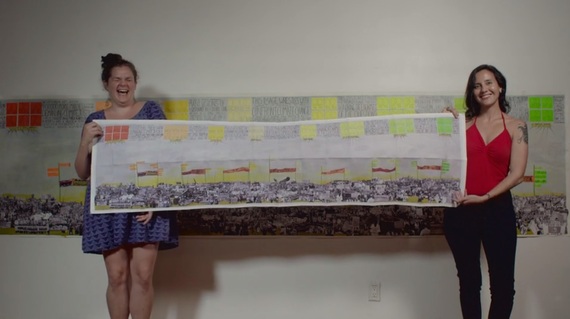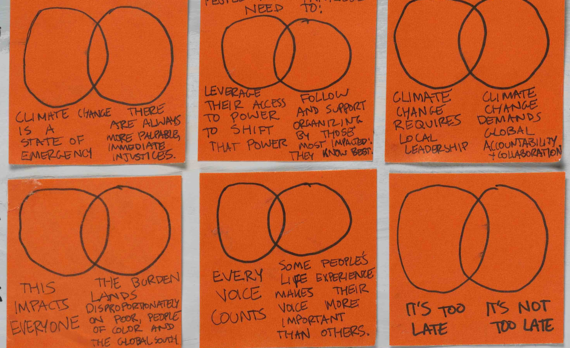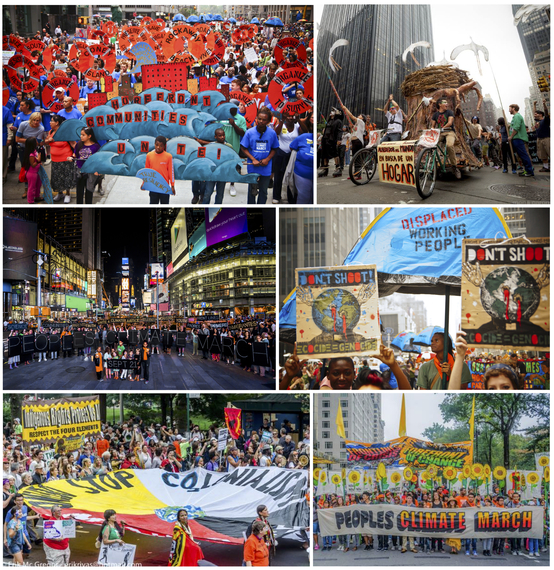There are experts in little things, but there are no experts in big things. All of us, no matter what we do, have the right to make moral decisions about the world....Everyone must be involved.People say 'you have to be professional.' The historian says 'it's not that I don't think the US should get out [of the war], but we are just historians. It's not our business.' Then the businessman says 'it's not my business.'. The artist says 'it's not my business.' Then whose business is it?
-Howard Zinn
This is a quote from an essay by historian Howard Zinn called Artists in Times of War. Zinn argues that many of us distance ourselves from the problems of the world: we feel that it is "not our job" to fix them. History shows us, he says, that when artists choose to use their skills to address the troubles of our time, it makes it easier for other people to imagine how they too can make demanding change a meaningful part of their own lives. When artists act, society follows, and real change happens.
I am an artist who came of age in the era of Occupy, and it was seeing my illustration of the Occupy movement's declaration spread across the internet that first made me an activist. These days, most of my work is in service of confronting the climate crisis, a struggle where artists' leadership is urgently needed. Earlier this month, I released an image called Confronting the Climate: A Flowchart of the People's Climate March. I imagine this project as a response to Zinn's mandate for artists.

Confronting the Climate: A Flowchart of the People's Climate March
On the surface, this is an image about the People's Climate March- a watershed moment in the climate movement, two years ago, when 400,000 people descended on Manhattan to share how the climate crisis impacts and outrages them, and to demand bold action from global leaders. What struck me as powerful about this march was how it allowed the climate movement to see itself: a cacophony of peoples, motivated to cry out in the face of a dauntingly complex, global-scale problem.
As anyone who helped make the People's Climate March happen will attest, it was not simple. Basic questions such as "What should the march be called? Who should stand in front? What should we say?" were belabored for months, in a dizzying array of committees, coalitions, and public forums. The efforts involved global NGOs, tiny local community groups, and nearly every other kind of group that humans organize themselves into. Confronting the Climate: A Flowchart of the People's Climate March is a map of that moment in history that connects the pictures and stories of the people at People's Climate March to the biggest questions about what it takes to truly confront climate change.
Society has long leaned on artists to see the poetry in the arduous work of mass mobilization. What social movement has succeeded without masses of people in the street, and also without gripping images and inspiring songs to bring those crowds to life? As the coordinator of the People's Climate March arts team, I worked to create the conditions needed for artistic activity to thrive in this moment. The core team of 7 cultural organizers (Raquel de Anda, Kevin Buckland, Beka Economopoulos, Remy Fredenberg, Gan Golan, Kate McNeely and Oja Vincent) held open assemblies for creative visioning about the march, transformed the Mayday Space into a fully stocked, 3 story arts and mobilization hub, reached out to our vast collective networks of cultural workers to invite them to participate, and organized more than 40 community-arts projects across the city that delivered the many stories of why people were choosing to march that day. Finally, we worked with organizers to stitch all these projects together, so that when this art joined the masses in the streets, we told an inclusive, beautiful story of today's climate movement.
After the People's Climate March ended, it was hard to describe what had happened. The anecdotes that I saw in the media failed to convey the breadth and the complexity of what took place, and I began to feel we needed another way to communicate about this event: not just for the history books, but for the future of the fight against climate change.
As big and bold as the People's Climate March was, we need to do so much more. We need to get much more specific than demanding "bold action on climate." We're going to have to march many more times, and also do many things besides marching. This will require acts of collective moral clarity and coordinated bravery on an unprecedented scale. We need to be able to point to the People's Climate March, to remind ourselves that it was possible, so that- as ambitious as that march was- we can be wildly more ambitious and brave in the years to come.
The People's Climate March is an example of what is possible when we are not deterred by complexity. My map of the march names many unsolvable contradictions of our world, and lifts up the experiences of real people choosing to act in the face of these contradictions. The print edition that you can currently pre-order through Kickstarter is 6 feet long. I joke that it is art for hallways- because where else does it fit? There are hallways in schools, in churches, in doctors offices, in senior centers, and probably in your home, too. This art project is an invitation to fill an empty space or a quiet moment in your life with an ongoing, complex conversation about climate change. I don't pretend this project is going to solve the climate crisis- but neither do I want to shy away from the transformative potential art carries, or the scale of what is possible when all of us choose to step out from our daily routine, and into the giant, messy work of transforming our world.

A picture of me holding my new artwork and laughing, alongside social movement artist and oral historian Fernanda Espinosa. This is a still from the video about this project that you can watch here:

